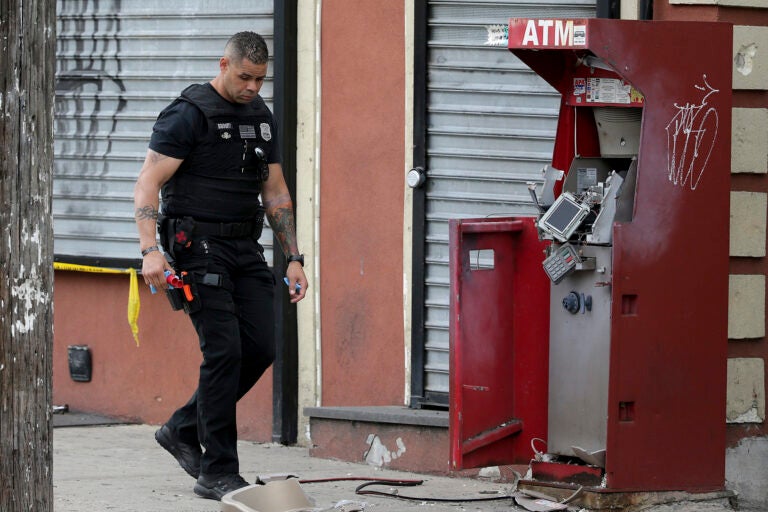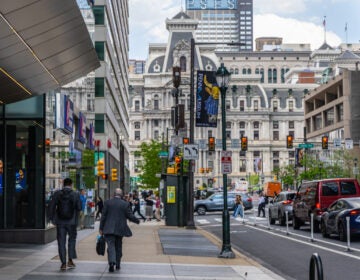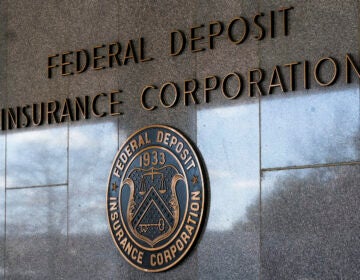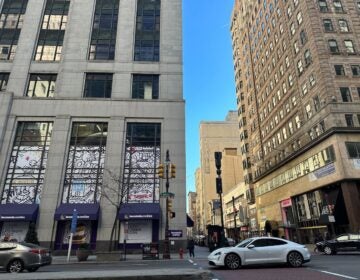Money goes boom: Philly’s history of exploding ATMs
Experts say the spate of ATM explosions have nothing to do with political protest.

A member of the Philadelphia bomb squad surveys the scene after an ATM machine was blown-up at 2207 N. 2nd Street in Philadelphia, Tuesday, June 2, 2020. (David Maialetti/The Philadelphia Inquirer via AP)
Sam Kap was having dinner in her living room Sunday night when a giant boom from the street shook her third-floor apartment.
“It was like nothing I had ever heard before,” said Kap, who lives on Girard Avenue in Francisville. “I knew it wasn’t a gunshot, I knew it wasn’t fireworks. It felt like what I can only describe as a small explosion or a bomb.”
She rushed to the window and saw a group of about 10 people milling around a small store at the Conoco gas station across the street. They soon fled. Five fire trucks and two police cars came roaring in, but with fires and other explosions roiling neighborhoods across the city, they left after just five minutes, she said.
“It felt like, what the heck is happening? I’d never felt an explosion or a bomb like that, or anything that would shake a house like that. That certainly was a little startling,” said Kap, a local comedian.
She later learned that someone had blown up the ATM at the gas station, leaving behind a wreck of melted parts and, apparently, making off with any money housed in the machine.
The bombing that interrupted Kap’s dinner was one of about 50 such attacks on ATMs between Saturday and Wednesday, according to Police Commissioner Danielle Outlaw. The vast majority of the cash machines were damaged by homemade M100 or M250 explosive devices, so-called “quarter sticks” resembling dynamite. Police responded to a total of 135 “explosive events” during that time, Outlaw said.
‘Independent actors’ using the ‘distraction of protest marches’
The ATM attacks, along with firecrackers and other explosions set off during the weekend’s looting and violence, accounted for some of the hundreds of booms residents reported hearing earlier this week. While rumors swirled that the startling noises were caused by law enforcement sonic weapons, officials say those claims are unfounded.
“We don’t even have sonic equipment in our inventory,” Lt. Col. Keith Hickox of the Pa. National Guard told Billy Penn. “I don’t even think I’ve seen something like that in my career. The only time I’ve seen those is in the ‘Incredible Hulk.’”
Exploding cash machines seems to be a pretty low-tech affair. One video of an ATM explosion posted on social media shows people running toward a machine, then white clouds of smoke billowing up around it. They scramble to pull cash out of the smoking ATM before running away. Blasted-open machines littered sidewalks as the group sped from one machine to the next.
In one incident in North Philadelphia, a group tried three times to empty a sidewalk ATM before one of the men died attempting to blow it up Tuesday. Another man was arrested this week after using Instagram to advertise dynamite for blowing up ATMs and admitting he had blown up several of the machines himself, Pennsylvania Attorney General Josh Shapiro said.
The city has seen cash machines bombed before. After four explosions in June 2018, for example, police arrested a woman for allegedly blowing one up in a Kensington beer store with an M100 stick.
Experts on ATM security say the string of explosions in Philadelphia this week is unprecedented. The U.S. has about half a million ATMs and probably fewer than 50 are blown up each year, said David Lott, a payments risk expert at the Federal Reserve Bank of Atlanta.
“The Philadelphia situation is a major change from the norm in that regard,” he said. “It surprised me when they said there were 50-plus attacks. That is highly unusual. Not just anybody can go out and acquire these explosives, and you have to have some level of knowledge to best utilize those.”
Lott was also surprised by the highly public nature of the explosions, with attackers brazenly setting off charges right on the street in densely populated neighborhoods. In other countries, criminals have been more discreet when they blow up ATMs, targeting rural or remote places, he said.
“Generally the explosives attacks have been predominantly to more isolated machines, as you would expect, just because of the fear of detection,” Lott said. In Philadelphia, “perhaps they’re using the distraction of the protest marches and things of that nature in order to carry out their deeds.”
The Federal Reserve expert said he has never heard of people attacking ATMs as a political act and believes the thieves were simply after the money. Kap said there were no protests happening anywhere nearby when the ATM on her street was blown up.
“I think a lot of people who are outside the city are hearing these reports and fearing that the Black Lives Matter folks are doing this destruction, which is obviously not the case. These are completely independent actors, just sort of working within the chaos of the current state of the city,” she said.
Rather than blowing up ATMs, in the U.S. it is more common for criminals to wrench cash machines off their moorings and take them elsewhere to be dismantled, said Lott, who once ran ATM and debit card programs for a regional bank.
In Texas and other states, people have driven vehicles through windows, attached chains to ATMs, and pulled them out of stores, or used forklifts and backhoes to pry up machines and smash them open, he said. Lott also noted that scams in which criminals install skimmers or cameras on ATMs to steal customers’ account information are more lucrative for thieves and more costly to banks than physical attacks.
ATM explosions have been more common in other countries. Europe has weathered more than 1,000 attacks in a wave that began about a decade ago, Lott said. In Britain, the Netherlands, and other countries, gangs carrying oxygen and acetylene tanks pump the gases through hoses into bank ATMs, blasting off the front of machines and yielding $100,000 or more per incident.
Dynamite attacks have become common in Brazil in the last few years. Heavily armed attackers routinely blow up both cash machines and vaults, in some cases detonating explosives across whole rows of ATMs at once. Unlike the recent Philadelphia thieves, the Brazilian gangs use real dynamite stolen from construction sites. The M100 and M250 devices used here do not contain nitroglycerin, the main ingredient in dynamite.

Subscribe to PlanPhilly
How to defend a cash machine
Defending against physical attacks on ATMs is a challenge, especially for owners of the smaller free-standing cash machines placed in stores, Lott said. In Europe, banks and ATM manufacturers have installed systems to release gases from machines before they explode, but stymieing solid explosives is difficult.
In addition to installing security cameras or limiting access to machines, some European banks have introduced machines that stain or degrade the currency in the ATM if the device is tipped or otherwise disturbed, said David Tente, USA executive director of the ATM Industry Association (ATMIA).
That method renders the currency useless, and makes it possible for ATM owners to exchange tainted bills for clean cash, reducing their losses. But Tente said it is not feasible for the small companies that put ATMs in gas stations, convenience stores, and other non-bank locations.
“I doubt we would see that in the U.S., at least not for some time, and not unless it got to be really, really prevalent, because it is an additional expense. Particularly for the independent operators, it would be difficult to do that for all their machines and a lot of times they’re just not built to handle that sort of countermeasure,” he said.
Some stores in Philadelphia have recently emptied their machines to discourage physical attacks, but that can make it harder for people who lack credit cards to access their money and make purchases.
Despite the trend seen and heard in Philadelphia over the last week, ATM explosions are still a less costly risk to banks than non-physical attacks on cash machines. But much about the crimes remain unclear, Tente said.
Financial institutions tend to be very secretive about attacks on their systems, making it difficult to understand the extent of the problem and the best way to prevent fraud and thefts, Tente said. He does not even know exactly how many physical attacks on ATMs occur every year.
“Typically, you’ll find that even the banks don’t allow their own fraud and security people to know how many attacks are going on,” he said.
Last year, the ATMIA acquired another organization, the ATM Security Association, and is working to create a databank of ATM crime information, as is already done by a similar organization in Europe.
“It would helpful, for example, to know if there’s a crew blowing up ATMs in your city and what part of the city they’re operating in,” Tente said. “But we just don’t get that kind of information very often.”
WHYY is your source for fact-based, in-depth journalism and information. As a nonprofit organization, we rely on financial support from readers like you. Please give today.






